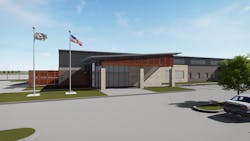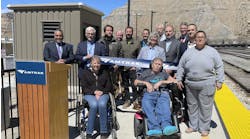Fort Bend County has celebrated the groundbreaking of its new transit center.
The facility is designed to accommodate the County’s existing fleet of buses as well as future additions. It includes 18,600 square feet of office space, 28,400 square feet of maintenance bays, covered bus parking, and a 7,100-square-foot fuel and washing station. The facility also contains a break area, relaxation lounge and kitchen spaces.
Engineering firm Lockwood, Andrews & Newnam, Inc. provided planning, engineering and design services for the new transit center. SpawGlass is serving as the contractor. Other firms involved in the project include RdlR Architects as the architect, Asakura Robinson as the landscape architect, and HDR | Maintenance Design Group for specialty equipment and systems.
Fort Bend County is one of the fastest growing counties in Texas and the nation. Its rapid population and employment growth have increased traffic congestion considerably. To address this growth, in January 2011, the Fort Bend County Transit completed a long-range transit plan. The plan includes several proposals to improve its existing bus and van services, and expand its system for the next 25 years. The new transit center is a significant component of this plan.
In conjunction with a service provider, the County maintains a fleet of buses, 60 and growing, to serve the needs of the residents. Bus operations, including dispatching and maintenance, are provided by the private contractor while County staff provide reservation, scheduling and administrative activities. Over the past several years, the County has performed these functions from four different facilities in the greater Houston area. The new facility will allow the County to combine its transportation functions into a single location for improved efficiency and service.
“Considerable time and money are spent each year transferring buses between each of the four facilities,” said Jeff Thomas, P.E., LAN’s senior associate and facilities team leader. “In addition, the costs of fueling vehicles at a different location from the depot are significant. By consolidating its operations, maintenance and administrative functions in a single location, the County will be able to efficiently serve its customers while saving a lot of money.”
Construction of the $21 million project is scheduled to be completed in October 2019.


